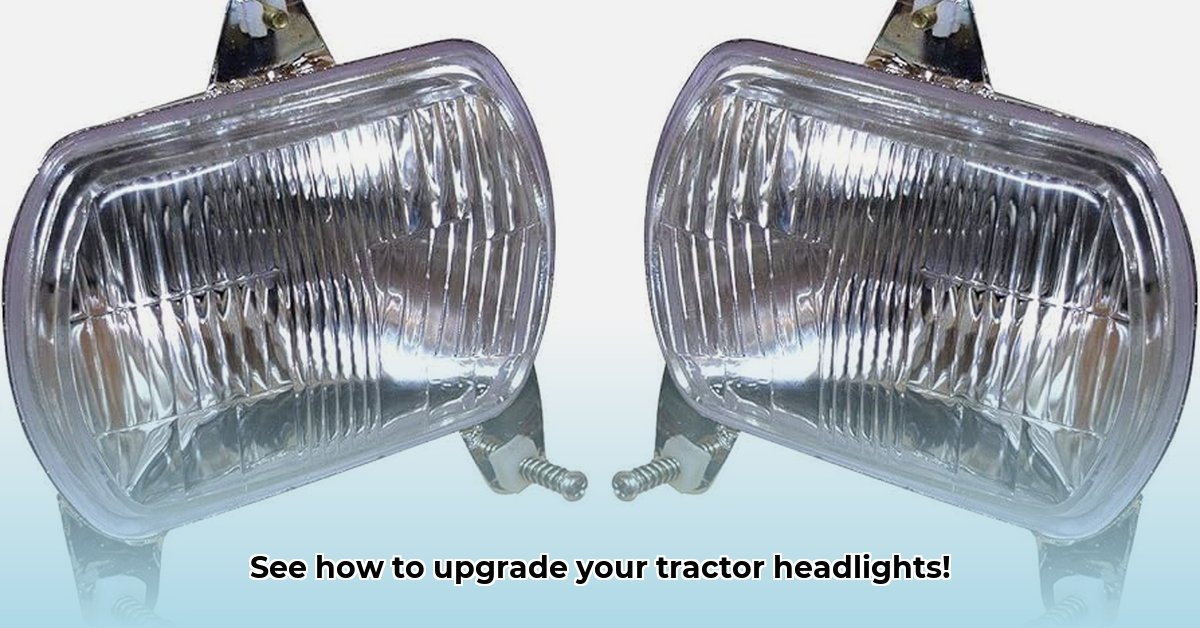
Tractor Headlamp Upgrades: Boosting Efficiency Today
Farming demands long hours, often extending into low-light conditions. Effective tractor lighting isn't just about visibility; it's crucial for safety, productivity, and environmental responsibility. Outdated headlamps lead to accidents, wasted fuel, and reduced efficiency. Upgrading to modern lighting technologies offers a significant return on investment and contributes to sustainable farming practices. This article details the benefits of upgrading, guides you through the selection process, and explores future trends in tractor lighting. For more options, check out these tractor lights.
Shining a Light on Modern Tractor Headlamp Technology
Two primary headlamp technologies dominate the market: halogen and LED. Understanding their differences is key to making an informed decision.
| Headlamp Type | Advantages | Disadvantages | Typical Lifespan (Hours) | Energy Efficiency |
|---|---|---|---|---|
| Halogen | Inexpensive initial cost, widely available | High energy consumption, short lifespan | 500-1000 | Low |
| LED | High energy efficiency, long lifespan, bright light | Higher initial cost | 50,000+ | High |
Halogen headlights, while initially cheaper, consume considerably more energy and require frequent replacements, leading to increased operational costs and waste. The constant cycle of purchasing and disposing of bulbs contributes to environmental burden.
LED headlights, despite the higher upfront cost, deliver substantial long-term savings. Their superior energy efficiency, extended lifespan (up to 50,000+ hours), and brighter light output significantly reduce operational expenses and minimize environmental impact. Isn't it worth considering the cumulative costs of frequent halogen bulb replacements?
Environmental Impact: A Brighter Future for Your Farm and the Planet
The environmental benefits of switching to LED headlights are significant. Their lower energy consumption directly translates to reduced greenhouse gas emissions. Furthermore, LEDs contain fewer hazardous materials than halogens, simplifying disposal and minimizing environmental impact at the end of their lifespan. This transition aligns with the growing need for sustainable agriculture practices. How much could your farm reduce its carbon footprint by switching to LEDs?
The Economics of Illumination: Making it Pay Off
The initial investment in LED headlights is offset by long-term cost savings stemming from several key factors:
- Reduced Energy Consumption: LEDs significantly reduce your electricity bill, resulting in substantial savings over their lifespan.
- Lower Replacement Costs: The extended lifespan of LEDs drastically reduces the frequency of bulb replacements, eliminating recurring expenses.
- Improved Productivity: Superior visibility enables longer working hours, potentially increasing output and profitability.
- Safety Enhancement: Improved nighttime visibility minimizes the risk of accidents, reducing potential costs associated with repairs, downtime, and injuries.
A thorough cost-benefit analysis, considering these factors, will clearly demonstrate the long-term financial advantages of LED technology. What's the hidden cost of poor visibility and frequent bulb replacements on your farm?
Practical Steps to Upgrade Your Tractor Headlights
Upgrading your tractor’s headlights is a relatively simple process but requires careful execution. Follow these steps:
- Assess your lighting needs: Consider field size, terrain complexity, and frequency of nighttime operation to determine the appropriate light intensity and beam pattern.
- Choose compatible LEDs: Select LEDs compatible with your tractor's voltage and mounting system. Look for certifications and warranties to ensure quality and reliability. Consult your equipment dealer for recommendations.
- Professional installation (recommended): While some may attempt DIY installation, professional installation ensures correct wiring, optimal performance, and safety.
- Thorough testing: Before operation, meticulously test the new headlights to confirm proper function, alignment, and brightness.
The Future is Bright: Emerging Trends in Tractor Lighting
Technological advancements in tractor lighting continue. Smart lighting systems, integrated with precision farming technology, automatically adjust brightness and beam patterns based on real-time conditions. This optimization enhances efficiency and safety, further minimizing energy waste. Imagine headlights that adapt to varying light levels or focus precisely on the task at hand.
Conclusion: Illuminate Your Efficiency
Upgrading your tractor's headlights offers a clear path to enhanced efficiency, improved safety, and reduced environmental impact. While the initial investment in LEDs might seem higher, the long-term benefits – energy savings, reduced maintenance, increased productivity, and environmental responsibility – clearly justify the upgrade. Embrace sustainable practices and illuminate your farm's success.